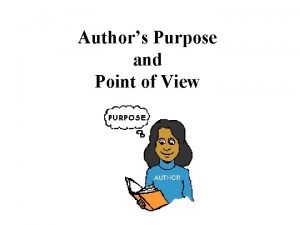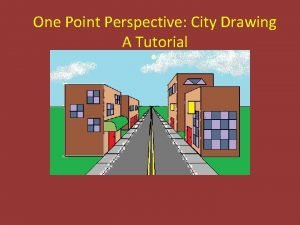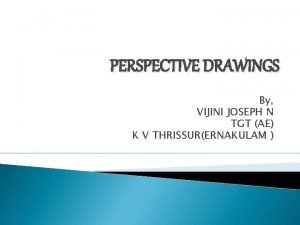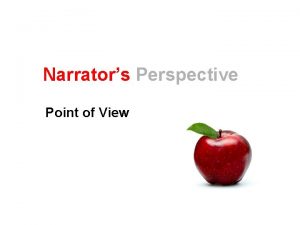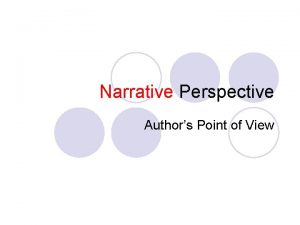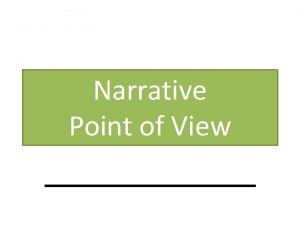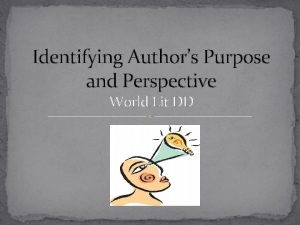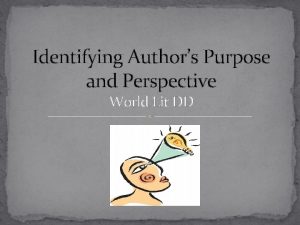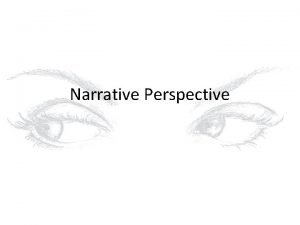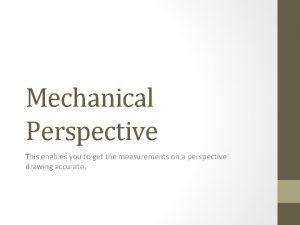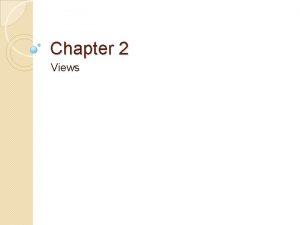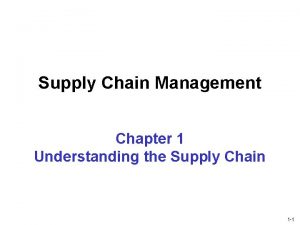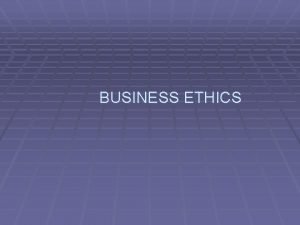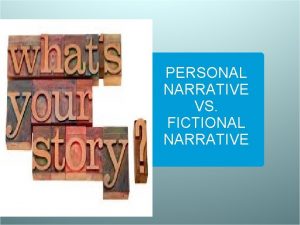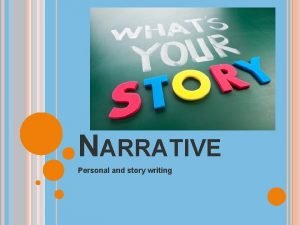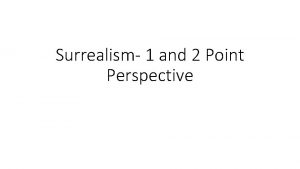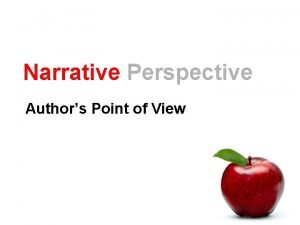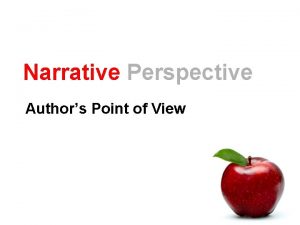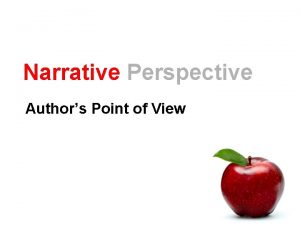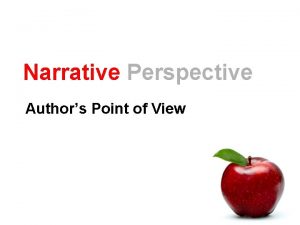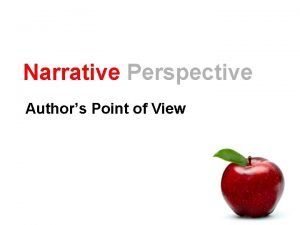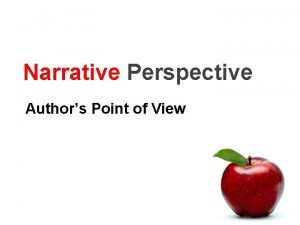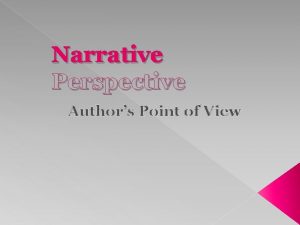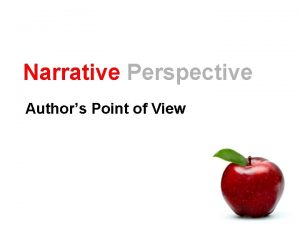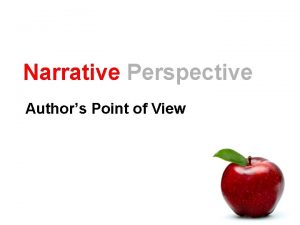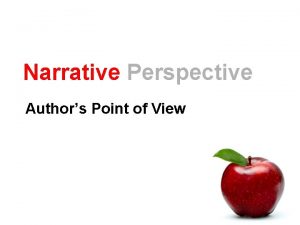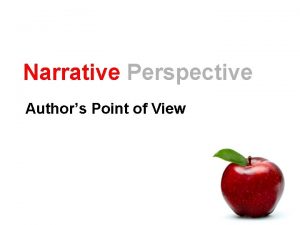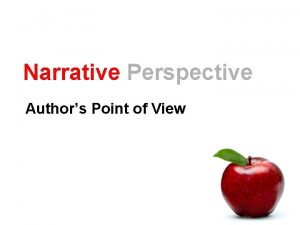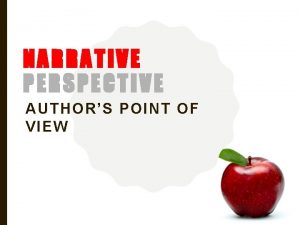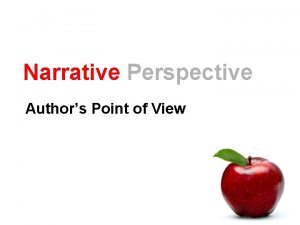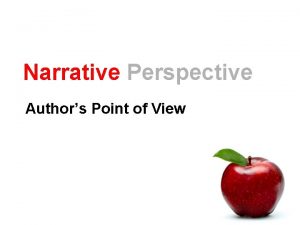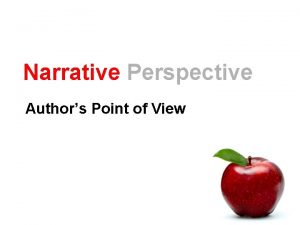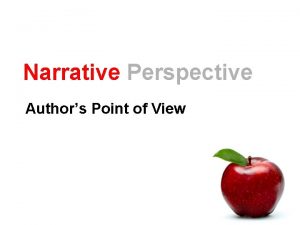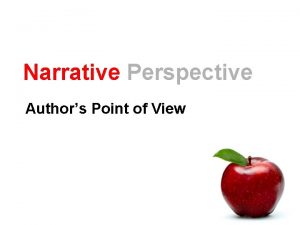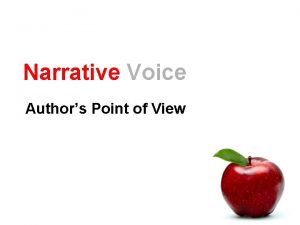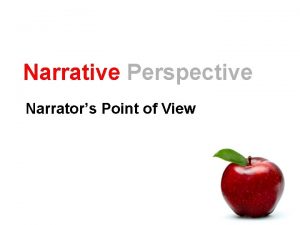Narrative Perspective Authors Point of View Dialogue and






























- Slides: 30

Narrative Perspective Author’s Point of View

Dialogue and Narration Dialogue = when characters speak. Narration = when the narrator speaks. “Quotation marks” separate narration from dialogue. Example “Help” my cousin Jack said. 1 2

Identifying Narrative Perspective (Point of View) It's about the narrator (who tells the story) We're not looking at dialogue. We don't care what characters say. Only the narrator's voice matters.

Pronoun Case We are trying to figure out the narrator's view point on the story. Perspectives and Signal Words First-Person I, me, my, mine, we, us, ours Second-Person you, your Third-Person he, she, her, they, them (also character's names)

This may help you remember: “I am in the room” I = 1 st Person “You come in the room. ” You = 2 nd Person “Then he or she came in the room. ” He or She = 3 rd Person

First-Person Narrator is a part of the story (character). Often uses I or we. Example I went home. Tim came over. I couldn't play.

Second-Person Usually for instructions Uses “You”; from “your” perspective. Examples First, gather your materials. Add 1 cup sugar to flour.

Third-Person Narrator usually isn’t involved. Tells other's stories. Lots of “He, ” “She, ” & character names. Three Types of Third-Person Narration Does the narrator tell… Thoughts and Feelings of Characters?

Third-Person Omniscient Narrator is all knowing. Narrator tells thoughts and feelings of more than one character. Omni = All Scient = Knowing Example Tim was mad at Shay. He blamed her. Shay knew Tim would be mad, but she wanted to live her life.

Third-Person Limited Narrator is limited to one character. Tells thoughts & feelings of one character Example Tim was mad at Shay. He blamed her. Shay just left without saying anything. She left a note and then left him.

Third-Person Objective Narrator does not reveal any character’s thoughts or feelings. Only character’s dialogue and actions are narrated. Example Tim slammed the door. He walked upstairs & read a note from Shay. He kicked his trash can & started crying.

Tips on Identifying Check 1 st or 2 nd-person before worrying about objective, limited, or omniscient. Ask, “Who’s story is the narrator telling: his, mine, or someone else’s? ” Focus on narration not dialogue.

POV Practice 1. Read the following passages. 2. Determine the narrator’s perspective (POV). 3. Write down your answer.

1 When I was four months old, my mother died suddenly and my father was left to look after me all by himself… I had no brothers or sisters. So through boyhood, from the age of four months onward, there was just us two, my father and me. We lived in an old gypsy caravan behind a filling station A. First person B. Second person C. Third person limited D. Third person omniscient E. Third person objective

2 The huge man dropped his blankets and flung himself down and drank from the surface of the green pool. The small man stepped behind him. "Lennie!" he said sharply. "Lennie, for God’s sakes don’t drink so much. " Lennie continued to snort into the pool. The small man leaned over and shook him by the shoulder. "Lennie you gonna be sick like you was last night. " Lennie dipped his whole head under, hat and all… "Tha’s good, " he said. "You drink some, George. " He smiled happily. A. First person D. Third person omniscient B. Second person E. Third person objective C. Third person limited

3 The previous night, make your plans for the next day and write them down… If you attend an exclusive Samurai’s party and feel timid, you cannot do your part in making it a successful party. You had first better prepare by convincing yourself that you will have a grand time. And you should feel grateful for the invitation. A. First person D. Third person omniscient B. Second person E. Third person objective C. Third person limited

4 Harold Davis took a deep breath and slowly started to peel the gauze from the wound on his grandmother’s leg. “Hold on, Grandma. I’m almost done, ” He said quietly. “Don’t worry, baby. It doesn’t hurt too much, ” she quietly replied. “Just take your time. ” Harold glanced up at his grandmother lying on the couch. He could tell she was in pain from the way she gripped the cushions, but still she managed to smile back at him. A. First person D. Third person omniscient B. Second person E. Third person objective C. Third person limited

5 They were standing under a tree, each with an arm round the other's neck, and Alice knew which was which in a moment, because one of them had "DUM" embroidered on his collar, and the other "DEE. " "I suppose they've each got "TWEEDLE" round at the back of the collar, " she said to herself. They stood so still that she quite forgot they were alive, and she was just looking round to see if the word "TWEEDLE" was written at the back of each collar, when she was startled by a voice coming from the one marked "DUM. ” A. First person D. Third person omniscient B. Second person E. Third person objective C. Third person limited

Identifying POV in Picture Books With your tablemates, skim through the picture book you read last week when we were studying conflict. What is the POV of your book? First person? Third person limited? Third person omniscient? Third person objective? § If it is in third person, which character(s) thoughts and feelings are revealed? (include page #s) § Find a passage (one or two sentences) that shows the POV. § Why do you think the author chose this POV?

Objective Common Core Standards RL 6: Analyze how differences in the points of view of the characters and the audience create effects such as suspense or humor. RL 1: Cite textual evidence By the end of the lesson, each student will be able to identify the point of view of the story, analyze, and evaluate this perspective in a reading response journal entry that will be evaluated using a standards-based rubric.

Thinking Levels

First person narrator: Story is told from the inside; narrator is a participant in the action Narrator is often the protagonist or minor character; we see only what he/she sees, in the way that he/she sees it. Advantage: You experience the events with the narrator, you connect with the narrator, it feels natural for the narrator to tell us their thoughts and feelings (as if they were talking to us) Disadvantage: the author (and reader) may be frustrated in that he/she can only include things that the narrator would be expected to know; author can only show us thoughts and feelings of other characters; we are locked within the mind of the narrator.

Third-Person Omniscient narrator: godlike narrator; he/she can enter character's minds and know everything that is going on, past, present, and future. Advantage: very natural technique because the author is omniscient regarding his work (they are his ideas). Disadvantage: unrealistic; narrator knows and tells all; this can only exist in literature.

Third-Person Limited Narrator: third person narration that is limited to the point of view of one character in the novel; may be a protagonist or a minor character. Not as common as omniscient. Advantage: can help create suspense because the reader learns things about the other characters when the character does Disadvantage: Can be hard for the writer to maintain

Third-Person Objective Narrator: limited narrative, like a drama; narrator can only describe words and actions that can be seen objectively and cannot get into character's thoughts Advantage: forces author to show not tell, can be very descriptive Disadvantage: can seem distant, can make it difficult for readers to connect with characters, requires a skillful author

Point of View Journal Assessment Draw a line down the middle of the next available page of your composition book. Include these headings: Left Side: Text Right Side: Response Find a passage in your book that reveals the point of view of your book. You may need to pick more than one passage, especially if your book is 3 rd person omniscient. Your passage should not only show the point of view, but it should also show the advantages/disadvantages of this POV. For example, if you think your author chose 1 st person POV to help us connect to the narrator by revealing their thoughts and feelings, find a passage

Point of View Journal Assessment Right Side Response Questions: What is the POV of your book? What are the benefits and drawbacks of this POV? Why do you think the author chose this POV? How would the story be different if it were told from a different POV? Use specific phrases and details from the passage for support. How does the point of view of the narrator affect how we view the characters? their struggles? Why is the story told from a particular point of view? How does the point of view affect the meaning and theme of the story? How does it affect our interpretation of the story?

Consider: What does the narrator know, and how does she know it? What does she tell the reader? How does she tell it? Why does she tell it? What might she be holding back, denying, or repressing? Why? What is the narrator's tone (attitude)? her agenda? Is she reliable? How does the point of view of the narrator affect how we view the characters? their struggles? Why is the story told from a particular point of view? How does the point of view affect the meaning and theme of the story? How does it affect our interpretation of the story?

Point of View Journal Example Text “While Sam Carr smiled and stroked the side of his face very delicately with the tips of his fingers, Alfred began to feel that familiar terror growing in him that had been in him every time he had got into such trouble” (Callaghan, 1). Response This passage demonstrates the third-person limited point of view that is used in the story. The story is told by an outside narrator who knows only the thoughts and feelings of Alfred. We only learn about Sam Carr through his actions, the things they say, and the thoughts that Alfred has about him. Although we don’t see into Sam’s thoughts, in this passage, he is smiling and stroking his face, which would suggest that he is quite pleased that he has caught Alfred in the act and he is looking forward to seeing what kind of punishment awaits. Sam’s character is developed indirectly, while Alfred’s character is developed both indirectly and directly (shown here). This method is effective because it allows us to see and understand first-hand how Alfred changes from the beginning of the story when he is only worried about getting into trouble, to the end of the story, when he is worried about how his poor choices have affected his mother’s health and well-being.

Point of View Journal Example Text Response “Oh please, don’t say anything, Victor pleaded with his eyes. I’ll wash your car, mow your lawn, walk your dog--anything! I'll be Your best student, and I’ll clean your erasers after school. Mr. Bueller shuffled through the papers on his desk, He smiled and hummed as he sat down to work. He remembered his college years when he dated a girlfriend in borrowed cars. She thought he was rich because each time he picked her up he had a different car. It was fun until he had spent all his money on her and had to write home to his parents because he was broke” (Soto, 7). This passage demonstrates the third-person omniscient point of view of the story. The narrator knows the thoughts and feelings of Victor, who is worried that Mr. Bueller will say something in front of Teresa about his terrible attempt at pretending to know French. We also know the feelings of Mr. Bueller, who is sympathetic to what Victor is going through. This point of view is effective because even though the focus of the story is Victor, this scene also tells us a lot about Mr. Bueller. The reader, and Victor discover that he is a pretty good guy who understands what his students are going through. So while 7 th grade can seem so scary, Victor learns that it isn’t all bad.
 One point perspective boxes
One point perspective boxes To entertain
To entertain What is the author's point of view
What is the author's point of view Drawing a city
Drawing a city 1 point perspective street view
1 point perspective street view The sociological perspective is a point of view that
The sociological perspective is a point of view that Narrator's perspective
Narrator's perspective Congratulations dialogue
Congratulations dialogue 1st person point of view
1st person point of view Third-person limited
Third-person limited What is authors perspective
What is authors perspective What is authors perspective
What is authors perspective Silo perspective vs business process perspective
Silo perspective vs business process perspective What is perspective in a story
What is perspective in a story Identifying narrative perspective
Identifying narrative perspective Mechanical perspective
Mechanical perspective Bird's eye view vs worm's eye view
Bird's eye view vs worm's eye view Simple view and complex view
Simple view and complex view Simple view and complex view
Simple view and complex view Simple view and complex view
Simple view and complex view What is a partial view
What is a partial view Cycle view and push/pull view of supply chain
Cycle view and push/pull view of supply chain What is operating system
What is operating system Separatist view of business ethics
Separatist view of business ethics Isometric projection of cone
Isometric projection of cone Fictional narrative topics
Fictional narrative topics Difference between narrative and story
Difference between narrative and story Hub and spoke system advantages and disadvantages
Hub and spoke system advantages and disadvantages Kitchen two point perspective
Kitchen two point perspective 2 point perspective surrealism
2 point perspective surrealism City 2 point perspective
City 2 point perspective

